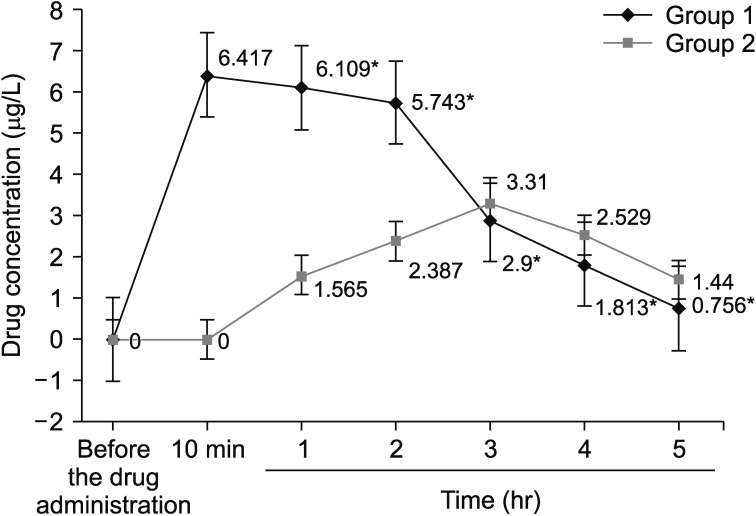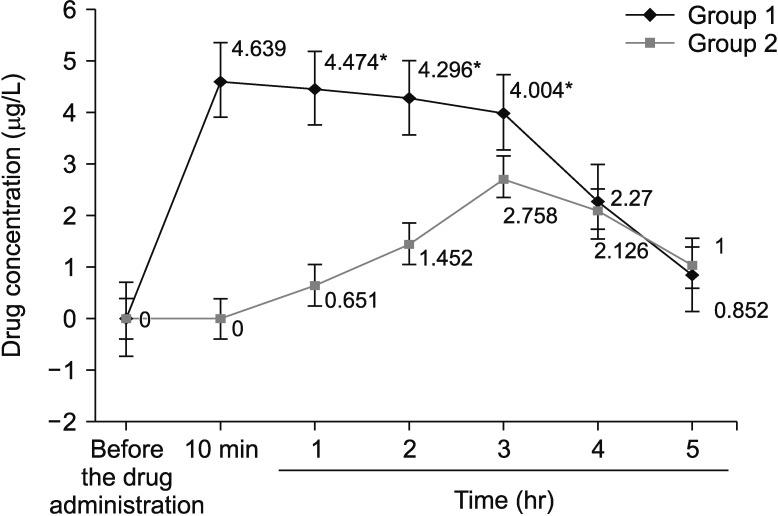Tuberc Respir Dis.
2020 Jan;83(1):96-103. 10.4046/trd.2019.0021.
Effectiveness of Intravenous Isoniazid and Ethambutol Administration in Patients with Tuberculosis Meningoencephalitis and HIV Infection
- Affiliations
-
- 1Department of Phthisiology and Pulmonology, Kharkiv National Medical University, Kharkiv, Ukraine. dddimad@gmail.com
- 2Department of Technologies of Treatment of Nonspecific Lung Diseases, National Institute of Phthisiology and Pulmonology named after F. G. Yanovskyi NAMS of Ukraine, Kiev, Ukraine.
- 3Department of Resistent Tuberculosis, National Institute of Phthisiology and Pulmonology named after F. G. Yanovskyi NAMS of Ukraine, Kiev, Ukraine.
- 4Department of Infectious Diseases, Kharkiv National Medical University, Kharkiv, Ukraine.
- 5Department of Research, Kharkiv National Medical University, Kharkiv, Ukraine.
- 6Department of Biochemistry, Kharkiv National Medical University, Kharkiv, Ukraine.
- 7Department of Neurology, Kharkiv National Medical University, Kharkiv, Ukraine.
- 8Department of Medicine, National Institute of Phthisiology and Pulmonology named after F. G. Yanovskyi NAMS of Ukraine, Kiev, Ukraine.
- 9Department of Criminalistics and Forensic Science, Kharkiv National University of Internal Affairs, Kharkiv, Ukraine.
- 10Department of Internal Medicine, V.N. Karazin Kharkiv National University, Kharkiv, Ukraine.
- KMID: 2466625
- DOI: http://doi.org/10.4046/trd.2019.0021
Abstract
- BACKGROUND
The aim of this study was to investigate the effectiveness of intravenous isoniazid (H) and ethambutol (E) administered in patients with new sputum positive drug-susceptible pulmonary tuberculosis (TB) with tuberculous meningoencephalitis (TM) and human immunodeficiency virus (HIV) co-infection in the intensive phase of treatment.
METHODS
Fifty-four patients with TB/TM and HIV co-infection were enrolled for this study. Group 1 comprised of 23 patients treated with E and H intravenously, while rifampicin and pyrazinamide were prescribed orally. Group 2 consisted of 31 patients treated with the first-line anti-TB drugs orally. The concentrations of H and E in blood serum were detected using a chromatographic method.
RESULTS
A significant improvement in the clinical symptoms and X-ray signs in patients treated intravenously with H and E was observed and compared to group 2. The sputum Mycobacterium tuberculosis positivity was observed during the second month of the treatment in 25.0% of patients from group 1 and 76.1% of the patients from the control group (p=0.003). In addition, nine patients (39.1%) died up to 6 months when H and E were prescribed intravenously compared with 22 (70.9%) in group 2 (p=0.023).
CONCLUSION
In TB/TM with HIV, the intravenous H and E treatment was more effective than oral H and E treatment at 2 months of intensive treatment in sputum conversion as well as in clinical improvement, accompanied by significantly higher mean serum concentrations. In addition, the mortality rate was lower in intravenous H and E treatment compared to oral treatment.
Keyword
MeSH Terms
Figure
Reference
-
1. Sanchez YP, Rodriguez DR. Tuberculosis meningitis, still misunderstood. J Neuroinfect Dis. 2015; S2:005.
Article2. Mai NT, Dobbs N, Phu NH, Colas RA, Thao LT, Thuong NT, et al. A randomised double blind placebo controlled phase 2 trial of adjunctive aspirin for tuberculous meningitis in HIV-uninfected adults. Elife. 2018; 7:e33478. PMID: 29482717.
Article3. Thwaites GE, van Toorn R, Schoeman J. Tuberculous meningitis: more questions, still too few answers. Lancet Neurol. 2013; 12:999–1010. PMID: 23972913.
Article4. World Health Organization. Global tuberculosis report 2017. WHO/PDF/TB/2018 [Internet]. Geneva: World Health Organization;2018. cited 2018 Sep 26. Available from: https://www.who.int/tb/publications/global_report/en/.5. Gao M, Gao J, Du J, Liu Y, Zhang Y, Ma L, et al. Efficacy of ultra-short course chemotherapy for new smear positive drug susceptible pulmonary tuberculosis: study protocol of a multicenter randomized controlled clinical trial. BMC Infect Dis. 2017; 17:435. PMID: 28629333.
Article6. World Health Organization. Guidelines for treatment of drug-susceptible tuberculosis and patient care. WHO/PDF/ TB/2017 [Internet]. Geneva: World Health Organization;2017. cited 2017 Apr 1. Available from: https://www.who.int/tb/publications/2017/dstb_guidance_2017/en/.7. Ruslami R, Ganiem AR, Dian S, Apriani L, Achmad TH, van der Ven AJ, et al. Intensified regimen containing rifampicin and moxifloxacin for tuberculous meningitis: an open-label, randomised controlled phase 2 trial. Lancet Infect Dis. 2013; 13:27–35. PMID: 23103177.
Article8. Butov DO, Zaitseva SI, Pitenko MM, Stepanenko GL, Butova TS. Morphological changes in experimental tuberculosis resulting from treatment with quercetin and polyvinylpyrrolidone. Int J Mycobacteriol. 2015; 4:296–301. PMID: 26964811.
Article9. Begley DJ. Delivery of therapeutic agents to the central nervous system: the problems and the possibilities. Pharmacol Ther. 2004; 104:29–45. PMID: 15500907.
Article10. Butov D, Feshchenko Y, Kuzhko M, Gumeniuk M, Butova T. Efficacy and safety of intravenous chemotherapy during intensive treatment phase in patients with newly diagnosed pulmonary tuberculosis. Adv Respir Med. 2018; 86:159–167.
Article11. World Health Organization. WHO case definitions of HIV for surveillance and revised clinical staging and immunological classification of HIV-related disease in adults and children. WHO/PDF/TB/2006 [Internet]. Geneva: World Health Organization;2006. cited 2006 Aug 7. Available from: https://www.who.int/hiv/pub/vct/hivstaging/en/.12. World Health Organization. Treatment of tuberculosis: guidelines, 4th ed. WHO/PDF/TB/2010 [Internet]. Geneva: World Health Organization;2010. cited 2018 Sep 26. Available from: https://apps.who.int/iris/bitstream/handle/10665/44165/9789241547833_eng.pdf?sequence=1.13. World Health Organization. HIV/AIDS treatment and care: clinical protocols for the WHO European Region. WHO ER/PDF/TB/2007 [Internet]. Geneva: World Health Organization European Region;2007. cited 2018 Sep 26. Available from: https://www.who.int/hiv/topics/idu/care/E90840.pdf.14. World Health Organization. Xpert MTB/RIF implementation manual: technical and operational ‘how-to’: practical considerations. WHO/PDF/TB/2014 [Internet]. Geneva: World Health Organization;2014. cited 2018 Sep 26. Available from: https://www.who.int/tb/publications/xpert_implem_manual/en/.15. Erokhin VV, Kornilova Z, Alekseeva LP. The specific features of the detection, clinical manifestations, and treatment of tuberculosis in the HIV-infected. Probl Tuberk Bolezn Legk. 2005; 20–28.16. Tsymbalar GG, Botoshanu E, Roshka SN, Burinskaia LP. Clinical picture and treatment of tuberculous meningitis in adults. Probl Tuberk. 1983; (3):51–53.17. Lapach SN, Chubenko AV, Babich PN. Statistical methods in biomedical studies using Excel. Kyiv: Morion;2000.18. Donald PR. Cerebrospinal fluid concentrations of antituberculosis agents in adults and children. Tuberculosis (Edinb). 2010; 90:279–292. PMID: 20709598.
Article19. Pouplin T, Bang ND, Toi PV, Phuong PN, Dung NH, Duong TN, et al. Naive-pooled pharmacokinetic analysis of pyrazinamide, isoniazid and rifampicin in plasma and cerebrospinal fluid of Vietnamese children with tuberculous meningitis. BMC Infect Dis. 2016; 16:144. PMID: 27039088.
Article20. Nguyen DT, Jenkins HE, Graviss EA. Prognostic score to predict mortality during TB treatment in TB/HIV co-infected patients. PLoS One. 2018; 13:e0196022. PMID: 29659636.
Article21. Kimerling ME, Phillips P, Patterson P, Hall M, Robinson CA, Dunlap NE. Low serum antimycobacterial drug levels in non-HIV-infected tuberculosis patients. Chest. 1998; 113:1178–1183. PMID: 9596291.
Article
- Full Text Links
- Actions
-
Cited
- CITED
-
- Close
- Share
- Similar articles
-
- Korean Guidelines for the Treatment of Tuberculosis
- Agranulocytosis Induced by Ethambutol in a Patient with Pulmonary Tuberculosis
- A Case of Tuberculosis Verrucosa Cutis
- Treatment of pulmonary tuberculosis in elderly
- Development of Multidrug Resistance during Standardized Treatment in a Patient with Drug-Sensitive Tuberculosis



